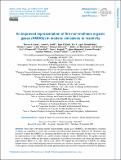An improved representation of fire non-methane organic gases (NMOGs) in models: emissions to reactivity
Author(s)
Carter, Therese S; Heald, Colette L; Kroll, Jesse H; Apel, Eric C; Blake, Donald; Coggon, Matthew; Edtbauer, Achim; Gkatzelis, Georgios; Hornbrook, Rebecca S; Peischl, Jeff; Pfannerstill, Eva Y; Piel, Felix; Reijrink, Nina G; Ringsdorf, Akima; Warneke, Carsten; Williams, Jonathan; Wisthaler, Armin; Xu, Lu; ... Show more Show less
DownloadPublished version (6.890Mb)
Publisher with Creative Commons License
Publisher with Creative Commons License
Creative Commons Attribution
Terms of use
Metadata
Show full item recordAbstract
<jats:p>Abstract. Fires emit a substantial amount of non-methane organic gases (NMOGs), the
atmospheric oxidation of which can contribute to ozone and secondary
particulate matter formation. However, the abundance and reactivity of these
fire NMOGs are uncertain and historically not well constrained. In this
work, we expand the representation of fire NMOGs in a global chemical
transport model, GEOS-Chem. We update emission factors to Andreae (2019) and
the chemical mechanism to include recent aromatic and ethene and ethyne model
improvements
(Bates
et al., 2021; Kwon et al., 2021). We expand the representation of NMOGs by
adding lumped furans to the model (including their fire emission and
oxidation chemistry) and by adding fire emissions of nine species already
included in the model, prioritized for their reactivity using data from the Fire Influence on Regional to Global Environments (FIREX) laboratory studies. Based on quantified emissions factors, we estimate
that our improved representation captures 72 % of emitted, identified NMOG
carbon mass and 49 % of OH reactivity from savanna and temperate forest
fires, a substantial increase from the standard model (49 % of mass,
28 % of OH reactivity). We evaluate fire NMOGs in our model with
observations from the Amazon Tall Tower Observatory (ATTO) in Brazil, Fire Influence on Regional to Global Environments and Air Quality (FIREX-AQ) and DC3 in the US, and Arctic Research of the Composition of the
Troposphere from Aircraft and Satellites (ARCTAS) in boreal Canada. We show that NMOGs,
including furan, are well simulated in the eastern US with some
underestimates in the western US and that adding fire emissions improves our
ability to simulate ethene in boreal Canada. We estimate that fires provide
15 % of annual mean simulated surface OH reactivity globally, as well as more
than 75 % over fire source regions. Over continental regions about half of
this simulated fire reactivity comes from NMOG species. We find that furans
and ethene are important globally for reactivity, while phenol is more
important at a local level in the boreal regions. This is the first global
estimate of the impact of fire on atmospheric reactivity.
</jats:p>
Date issued
2022Department
Massachusetts Institute of Technology. Department of Civil and Environmental EngineeringJournal
Atmospheric Chemistry and Physics
Publisher
Copernicus GmbH
Citation
Carter, Therese S, Heald, Colette L, Kroll, Jesse H, Apel, Eric C, Blake, Donald et al. 2022. "An improved representation of fire non-methane organic gases (NMOGs) in models: emissions to reactivity." Atmospheric Chemistry and Physics, 22 (18).
Version: Final published version